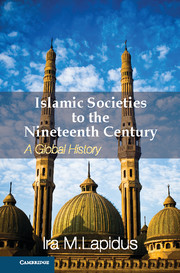Book contents
- Frontmatter
- Contents
- List of Illustrations
- List of Figures
- List of Maps
- List of Tables
- Preface
- Acknowledgments
- Acknowledgments to the first edition of A History of Islamic Societies
- Acknowledgments to the second edition of A History of Islamic Societies
- Publisher's Preface
- Introduction to Islamic Societies
- Part I The Beginnings of Islamic Civilizations
- Part II From Islamic Community to Islamic Society
- Part III The Global Expansion of Islam from the Seventh to the Nineteenth Centuries
- Chapter 25 Introduction: Islamic Institutions
- The Western Islamic Societies
- Islam in Asia
- Chapter 30 Introduction: Empires and Societies
- Chapter 31 The Turkish Migrations and the Ottoman Empire
- Chapter 32 The Postclassical Ottoman Empire: Decentralization, Commercialization, and Incorporation
- Chapter 33 The Arab Provinces Under Ottoman Rule
- Chapter 34 The Safavid Empire
- Chapter 35 The Indian Subcontinent: The Delhi Sultanates and the Mughal Empire
- Chapter 36 Islamic Empires Compared
- Chapter 37 Inner Asia From the Mongol Conquests to the Nineteenth Century
- Chapter 38 Islamic Societies in Southeast Asia
- Islam in Africa
- Conclusion
- Glossary
- Bibliography
- Annotated Bibliography from A History of Islamic Societies, 2nd Edition
- Index
Chapter 35 - The Indian Subcontinent: The Delhi Sultanates and the Mughal Empire
Published online by Cambridge University Press: 05 February 2013
- Frontmatter
- Contents
- List of Illustrations
- List of Figures
- List of Maps
- List of Tables
- Preface
- Acknowledgments
- Acknowledgments to the first edition of A History of Islamic Societies
- Acknowledgments to the second edition of A History of Islamic Societies
- Publisher's Preface
- Introduction to Islamic Societies
- Part I The Beginnings of Islamic Civilizations
- Part II From Islamic Community to Islamic Society
- Part III The Global Expansion of Islam from the Seventh to the Nineteenth Centuries
- Chapter 25 Introduction: Islamic Institutions
- The Western Islamic Societies
- Islam in Asia
- Chapter 30 Introduction: Empires and Societies
- Chapter 31 The Turkish Migrations and the Ottoman Empire
- Chapter 32 The Postclassical Ottoman Empire: Decentralization, Commercialization, and Incorporation
- Chapter 33 The Arab Provinces Under Ottoman Rule
- Chapter 34 The Safavid Empire
- Chapter 35 The Indian Subcontinent: The Delhi Sultanates and the Mughal Empire
- Chapter 36 Islamic Empires Compared
- Chapter 37 Inner Asia From the Mongol Conquests to the Nineteenth Century
- Chapter 38 Islamic Societies in Southeast Asia
- Islam in Africa
- Conclusion
- Glossary
- Bibliography
- Annotated Bibliography from A History of Islamic Societies, 2nd Edition
- Index
Summary
In the Indian subcontinent, Islam was introduced into an already developed civilization defined by agriculture, urbanization, higher religions, and complex political regimes. India was defined by the caste system, by Brahmanic Hinduism and Buddhist religions, and by Rajput and other Hindu political elites. In the past, there had been great empires, but on the eve of the Muslim invasions India was divided into numerous small states. The Muslim conquests brought a new elite and a new level of political integration, beginning the process of generating a new culture blending universal Muslim concepts and symbols of statecraft, cosmopolitan artistic pursuits such as architecture and painting, and regional motifs. In India, Muslim religio-communal orientations encompassed all of the principal varieties of scholasticism, Sufi orthopraxy, shrine worship, and reformism. In India, as opposed to Iran or the Ottoman Empire, a pluralistic religious society escaped bureaucratization and state control. The special cultural qualities of Indian-Islamic civilization and the autonomy and plurality of religious tendencies made it a distinctive variant of Islamic societies.
Afghanistan
The history of Islamic societies in the subcontinent began with the Arab invasions of 711–13, when Muslim rule was established in Sind, but the definitive Muslim conquest came from the post-ʿAbbasid military regimes in Afghanistan.
- Type
- Chapter
- Information
- Islamic Societies to the Nineteenth CenturyA Global History, pp. 507 - 537Publisher: Cambridge University PressPrint publication year: 2012



